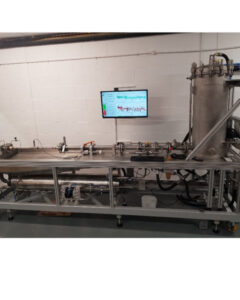Critical measurements for a critical industry
Water treatment ensures that communities have access to safe, high-quality water. The water treatment plant featured in this story is operated by a global company that leads the market in water and wastewater operations and maintenance (O&M) solutions, serving over 10 million people across the United States. With so many people depending on these plants for clean water, it’s crucial that the processes in these facilities run as safely and seamlessly as possible.
This particular water treatment plant stores ferric sulfate and sulfuric acid in five large tanks. These compounds play an important role in water treatment. Ferric sulfate is used as a coagulant, removing contaminants like suspended solids and phosphorus from water. Sulfuric acid is used to kill waterborne bacteria and return the water to a normal pH level. Plant personnel must ensure a healthy level of inventory for each of these compounds in order to ensure optimal treatment processes. Unfortunately, the ultrasonic sensors they were using made this quite a difficult task.
The struggles of ultrasonic
Each tank at the Florida facility was equipped with an ultrasonic level sensor and an accompanying display. In theory, this instrumentation would allow plant personnel to easily monitor the level of ferric sulfate and sulfuric acid in their tanks. In practice, however, both pieces of equipment proved unsuitable for the task.
Ultrasonic technology measures via sound waves that are reflected by the medium in the tank; an ultrasonic sensor computes measurements by calculating the distance from the total time elapsed between the ultrasonic wave’s emission and the reception by the process medium. Sound waves use air to travel through, meaning that they are highly affected by process and ambient conditions like temperature, vapors, or gases. That means that fluctuations in any of these factors can lead to unreliable measurements from ultrasonic sensors.
In the case of the water treatment plant, their ultrasonic sensors would frequently output inaccurate readings or would not provide a level measurement at all. Not only that, but the displays connected to these sensors were difficult to see, making it a chore for plant personnel to check level readings. Dissatisfied with the suboptimal inventory control provided by the ultrasonic instrumentation, the plant sought out a new solution. That search lead them to the leaders in radar level measurement: VEGA.
The radar advantage
The VEGADIS 82 displays the level visually from the ground
Radar technology presents a number of benefits for level measurement over ultrasonic. For one, it is unaffected by process and ambient conditions such as the issues detailed above. They are also capable of suppressing interference from buildup, another factor that can heavily influence ultrasonic measurements. And due to the precise signal focusing of 80 GHz radar technology, radar beams can be aligned almost precisely to the medium being measured; in contrast, ultrasonic sensors usually require interference signal suppression in such applications as pipes or pumps, narrow shafts, or deposits on walls.
VEGA outfitted the tanks at the water treatment facility with VEGAPULS C 21 radar sensors and VEGADIS 82 displays. VEGA’s series of low-cost radar sensors were designed with the needs of water and wastewater facilities in mind. Powered by 80 GHz radar technology, they contain all the advantages of radar level measurement in a small, affordable package for the price-sensitive applications found in the water and wastewater industry.
Moving forward with measurement confidence
With the VEGAPULS C 21, the water treatment plant now enjoys continuous, reliable level measurements along with an easy-to-read display in the form of the VEGADIS 82. Personnel love how easy to sensors and displays are to use, particularly the ability to connect to them via Bluetooth and make adjustments in the VEGA Tools mobile app. The plant has been so pleased with the performance of VEGA’s radar instrumentation that they have since purchased VEGAPULS 6X and VEGAMET units for lime silo level measurement. Backed by reliable radar technology, this water treatment plant is now better able to service the customers who rely on them.


Source of Article



